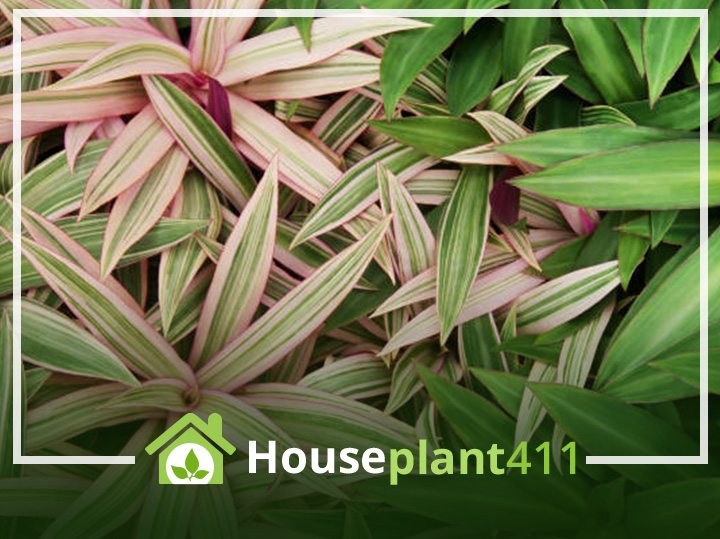Moses-in-the-Cradle or Tradescantia spathacea is a well-liked decorative plant indigenous to southern Mexico and Guatemala. It belongs to the Commelinaceae family of spiderworts and is valued for its lovely leaves and straightforward maintenance. There are different types of Moses in the Cradle, also known as oyster plant, boat lily, and Moses-in-a-basket.
This article will examine the several varieties of Moses-in-the-Cradle that exist and what makes each distinctive.
5+ Different Types of Moses in the Cradle
Here are the six types of Moses in the Cradle plants that are the perfect embellishment for any indoor garden.
Green Moses in the Cradle
The most prevalent kind of this plant, known as the green Moses in the Cradle, is distinguished by its dark green leaves, curled inward to resemble a cradle or a boat. The leaves may get up to 12 inches long and are ovate with a pointed tip. Their rich purple undersides provide a stunning contrast to the leaves’ green tops.
The hardy green Moses in the Cradle plant is tolerant of a variety of growth environments. It can grow in low-light situations but likes bright, indirect light. Moreover, it is drought-tolerant and has no problems in dry soil.

Variegated Moses in the Cradle
Beautiful Moses in the Cradle leaves have a striking pattern of white and green stripes on the variegated type. The white stripes on the leaf margins contrast well with the green in the middle of the leaf. Further to the aesthetic appeal are the vivid purple undersides of the leaves.
Similar growth conditions are needed for Moses’s green and variegated varieties in the cradle. It requires strong, indirect light and may thrive in seasons of dry soil. The white stripes on this species might turn brown if exposed to intense sunlight, so it’s crucial to keep that in mind.

Dwarf Moses in the Cradle
The dwarf Moses in the Cradle is a scaled-down counterpart of the common type, as the name indicates. It is ideal for compact places because it normally only grows to a height and width of approximately 6 inches. The cradle-like form of the leaves is still created by folding them inward, but they are now more tightly packed.
Similar to the ordinary species, the dwarf Moses in the Cradle needs favorable growth circumstances. It enjoys direct, strong light and may tolerate brief periods of dry soil. It might need to be watered more frequently to maintain the soil’s moisture due to its tiny size.

Vittata Moses in the Cradle
Another striped plant is the Vittata Moses in the Cradle, although its leaves are yellow rather than white stripes around the edges. Also lighter than the typical green variant is the heart of the leaves’ green color.
Similar growth conditions are needed for the normal variety and the Vittata Moses in the Cradle. It requires strong, indirect light and may thrive in seasons of dry soil. The yellow stripes on this type might turn brown if exposed to intense sunlight, so it’s crucial to keep that in mind.

Tricolor Moses in the Cradle
A gorgeous variation, the tricolor Moses in the Cradle has leaves with a distinctive pattern of green, pink, and cream stripes. The pink stripes on the margins of the leaves contrast well with the green in the middle. The cream stripes are amid the pink stripes to give even more visual intrigue.
Like the common type, the tricolor Moses in the Cradle needs favorable growth circumstances. It enjoys direct, strong light and may tolerate brief periods of dry soil. It might need to be fertilized more frequently due to its distinctive color to preserve its brilliant colors.

Purple Moses in the Cradle
Dark purple leaves with green edges are a distinctive characteristic of the purple Moses-in-the-Cradle type. Anthocyanins, pigments that give many plants their red, purple, and blue hues, give these plants their rich purple color. Visitors are usually drawn to the purple Moses in the Cradle, making it a wonderful addition to any indoor garden.
Similar growth conditions are needed for the normal variety and the purple Moses in the Cradle. It requires strong, indirect light and may thrive in seasons of dry soil. However, it’s vital to remember that this kind could be more prone to bright sunshine, resulting in the leaves fading or becoming brown.


Final Thoughts
In conclusion, Moses-in-the-Cradle is a lovely plant with several uses that may be found in various habitats. Each Moses in the Cradle variety has distinct qualities and requirements, from traditional green variations to spectacular, multicolored, uncommon yellow varieties.
A Moses-in-the-Cradle type is ideal for your space and skill level, regardless of whether you are an experienced indoor gardener or a novice. Moses in the Cradle plants are a lovely addition to any home or business due to their gorgeous leaves and simplicity of maintenance.

